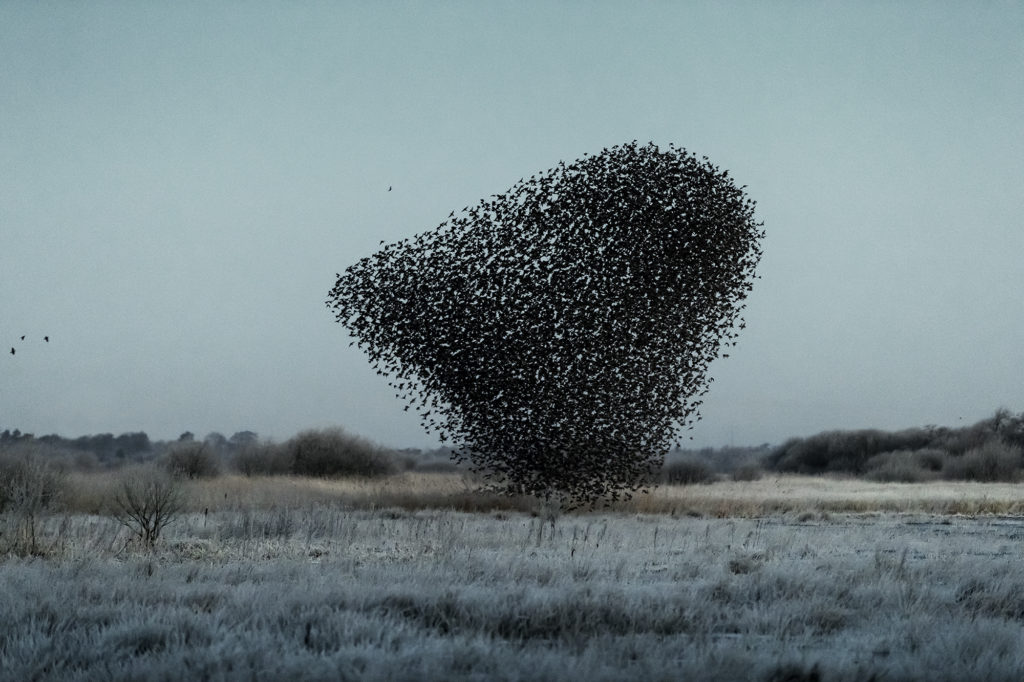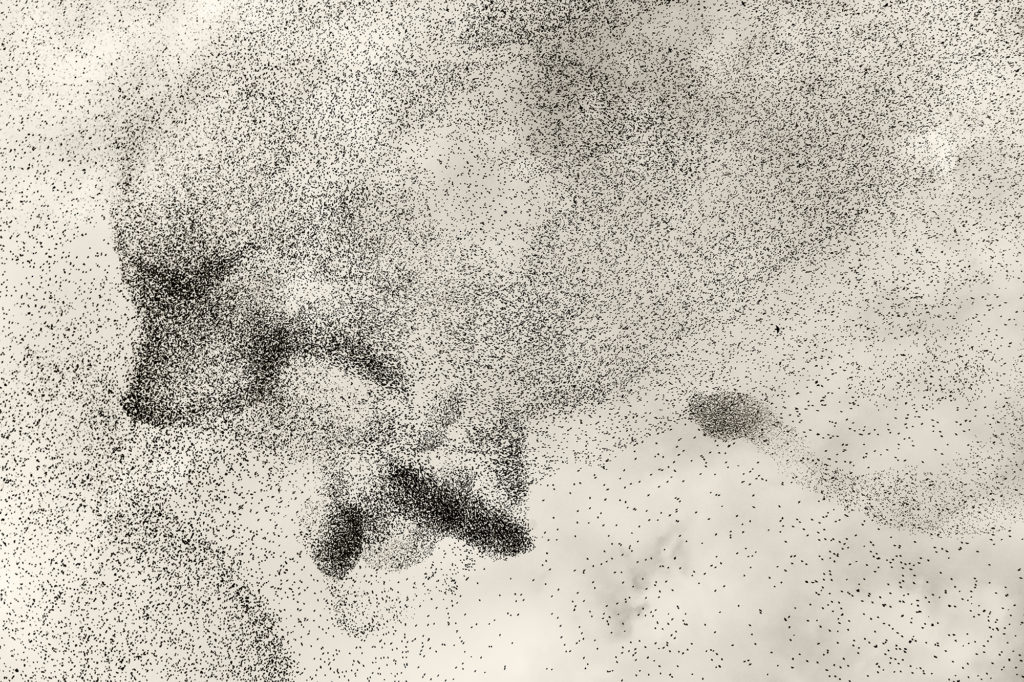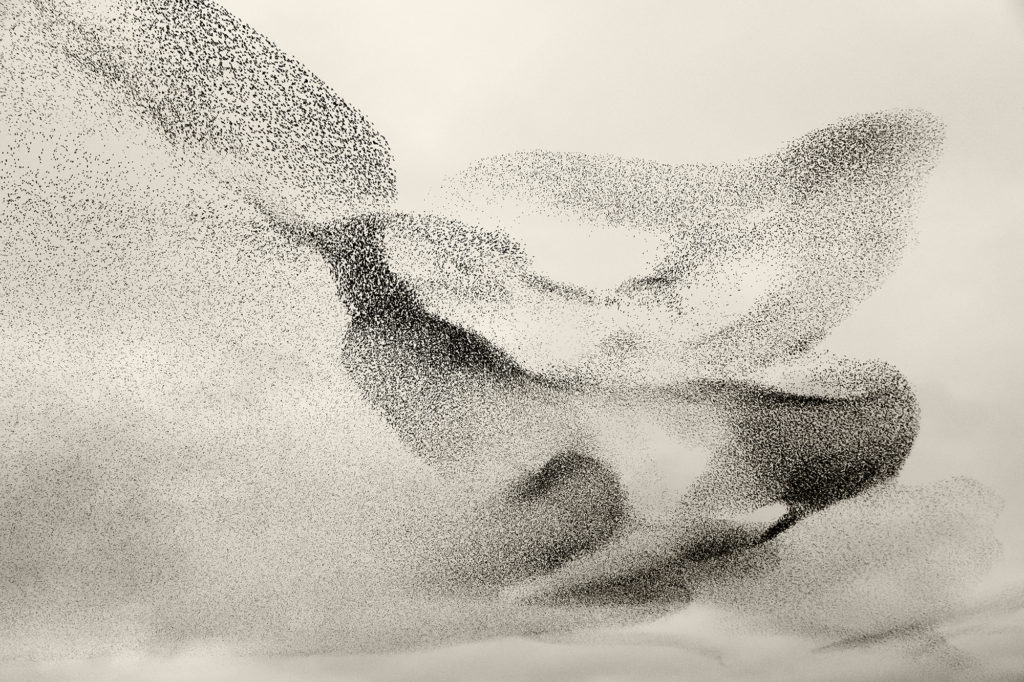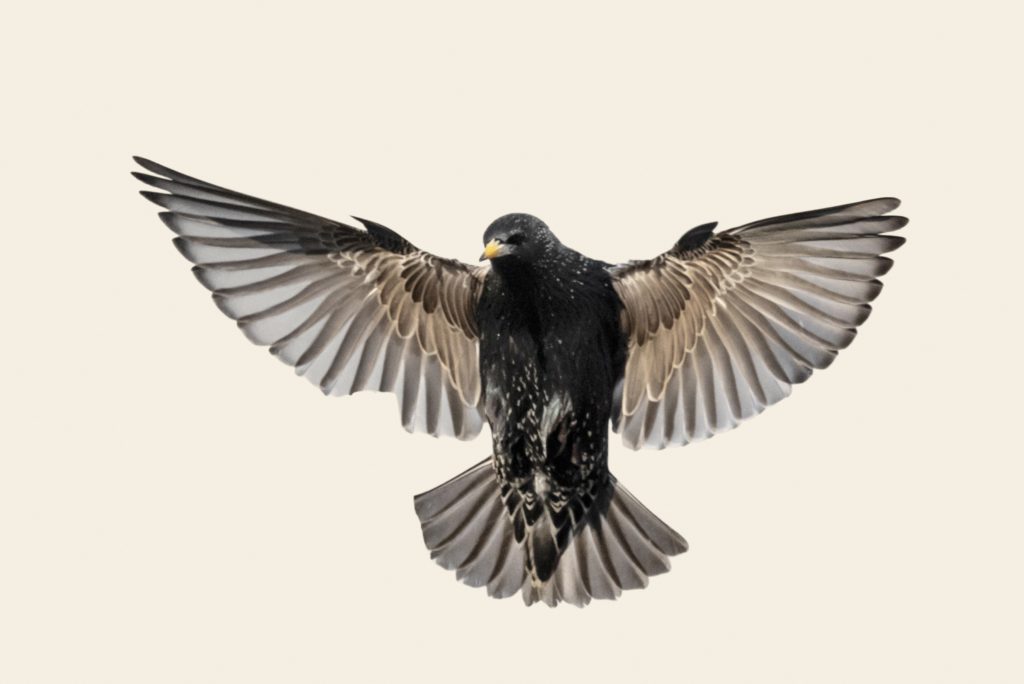It is one of the most fascinating natural phenomena: a giant starling cloud that colours the sky black. For his project Black Sun travels Danish photographer Søren Solkær through Europe to make these dance of life and death capture...
Text: Kirstin Hanssen Photography: Søren Solkær
"In Friesland, they are called sprotters," Solkær manages to tell us. He has just returned from yet another visit to Houtwiel marshland, near Dokkum, to take as many photos as possible of what he laughingly describes as an obsession. "In the morning, starling swarms break up into small groups to search for food, but in the late afternoon the birds gather. Starlings spend the night in groups and before occupying their roosts, they dance through the air in an ever-growing group. They often draw in the air beautiful figurative symbols, dolphins, hearts, and so on, but this really only happens when they are attacked by, for example, peregrine falcons or hawks.
 By flying closer together and turning their backs on the attacker, they form a swelling black plane, a 'black sun', as we call it in Denmark. You can often see where the attacker is located, for example enclosed in the middle. The starlings make amazing waves and together form a new, powerful and giant entity. How do starlings coordinate in their swarm? They are said to be able to see seven birds at once and their reaction time is 10 times faster than that of humans. There is no leader present, but there is swarm intelligence."
By flying closer together and turning their backs on the attacker, they form a swelling black plane, a 'black sun', as we call it in Denmark. You can often see where the attacker is located, for example enclosed in the middle. The starlings make amazing waves and together form a new, powerful and giant entity. How do starlings coordinate in their swarm? They are said to be able to see seven birds at once and their reaction time is 10 times faster than that of humans. There is no leader present, but there is swarm intelligence."
Japanese ink drawing
Starlings are flying nomads that always stay in different places in Europe. They are not migratory birds that leave for warmer places in winter. "In the Netherlands, they even stayed during the freezing cold spell earlier this year. In Rome, there is a group of several million birds that cause a lot of nuisance there. You often see men in Rome in white overalls, as protection against bird droppings, walking around with loudspeakers. From those speakers come warning sounds of starlings in danger, hoping to scare them away with them. The municipality has also imported falcons from the US to chase the birds away. Starlings, however, have been coming to Rome for centuries. These keep returning to the city."
"These days, I follow various hashtags on Instagram that allow me to know where starling populations are. Yes, sometimes I then take a plane or jump in the car to hopefully still be on time. Two years ago, I only knew that they come to Denmark every spring and autumn and set off with my camera for a week to the Wadden Sea. Capturing the birds on camera proved to be a difficult task.
 After a full week, I had exactly one picture that I felt had succeeded. Beautiful enough to evoke a fiery feeling in me. The cloud reminded me of a Japanese ink drawing of a stingray. What if I could get more of this quality? Let me go back another week and see if I could manage to get two more pictures out. Since then, I have been completely obsessed with the black sun phenomenon."
After a full week, I had exactly one picture that I felt had succeeded. Beautiful enough to evoke a fiery feeling in me. The cloud reminded me of a Japanese ink drawing of a stingray. What if I could get more of this quality? Let me go back another week and see if I could manage to get two more pictures out. Since then, I have been completely obsessed with the black sun phenomenon."
Magical experience
"Over the past two years, I have been out to photograph the starlings about 150 times. Of those, five or six evenings were incredible. Normally, my work is planned to perfection and I have a lot of influence on the end result. This project requires a huge amount of preparation time, with no guarantee of success. Which country do I want to be in? What is the best background, light, place? I don't want a distracting farm or high-voltage pylons in the picture. Is it raining or windy? Then the birds are likely to stay low to the ground. An ideal canvas forms a clear, blue sky or a thin layer of grey, combined with a low temperature, because then they fly very high. They also do so if there are dramatic clouds, but I don't want them in the picture, they ruin the composition.
 Attacks on starlings usually happen when the sun goes down. Tricky, because it increases risk of too little light. The birds fly at lightning speed, I have 1/500 of a second to freeze them, something impossible without a good camera. Also, my brain cannot even process what the camera sees. It is only at home that I then suddenly discover a whale shape in one of the photos. Sometimes I have to run half a kilometre to get closer or jump in the car to follow a group.
Attacks on starlings usually happen when the sun goes down. Tricky, because it increases risk of too little light. The birds fly at lightning speed, I have 1/500 of a second to freeze them, something impossible without a good camera. Also, my brain cannot even process what the camera sees. It is only at home that I then suddenly discover a whale shape in one of the photos. Sometimes I have to run half a kilometre to get closer or jump in the car to follow a group.
Everything happens in about 20 to 30 minutes. Luck is an important factor here. I had the most impressive experience on a winter evening in Friesland. Perhaps a million birds danced a crazy choreography, the most magical thing I have ever experienced in my life. Even the locals had never seen this before. It always takes away a bit of the experience when there are many 'starling spotters' present, but that night there were almost no other witnesses. So special. I captured that starling swarm on video and it went viral on social media."
Letting go of control
The output of Solkær's numerous trips over the past few years resulted in some 200,000 images, which he managed to reduce to a fine collection of a hundred photographs. These were compiled in his seventh book 'Black Sun' which, along with a special edition box, was released earlier this year. "What this project taught me? Black Sun is about being fully present in the moment. If I am not, I miss out on opportunities.
This project is a game of patience. It is about dedication and letting go of control." And at the same time, Solkær takes back control, when editing the material where he, among other things, accentuates colours, removes distracting elements and elevates his photography to art. The craftsman also prints all his work himself, on high-quality Japanese Awagami paper, made from mulberry fibres. "I am not a documentary photographer. What you see is my interpretation of reality. But I always leave the black sun intact; it reflects the language of the birds, or perhaps as the ancient Romans said, the word of God."
Find out more about this photographer HERE.
 SØREN SOLKÆR'S STYLE PASSPORT
SØREN SOLKÆR'S STYLE PASSPORT
Camera: Fujifilm GFX 100
Watch: "Don't wear it."
Bird: Sturnus vulgaris
Country: Tibet
Photographer: Nadav Kander
Outdoor clothing brand: Mammut
Favourite moment: Morning coffee
The birth of the idea
Søren Solkær graduated from FAMU, the Prague photo and film academy. Since 1993, he has mostly made a name for himself with iconic portraits of celebrities, from Björk to Paul McCartney. "Dutch photographer Anton Corbijn inspired me enormously. He told me that you have to know how to access the people who are the most difficult to approach."
His autonomous work has always come first. "I see commissioned work as something AFTER my own projects. No, not the other way around. Priority is executing my own art projects. After six portrait books, I thought about something new. Because after a quarter of a century of making portraits, I decided it was time for something different. And then I remembered something from my childhood.
I grew up in southern Denmark, in the countryside. My upbringing in nature was very different from the life I had so far as an adult. I saw the phenomenon of the 'black sun' twice when I was 10 years old, during a holiday near the Wadden Sea. Those dramatic images had never left my mind and so I decided to investigate..."



